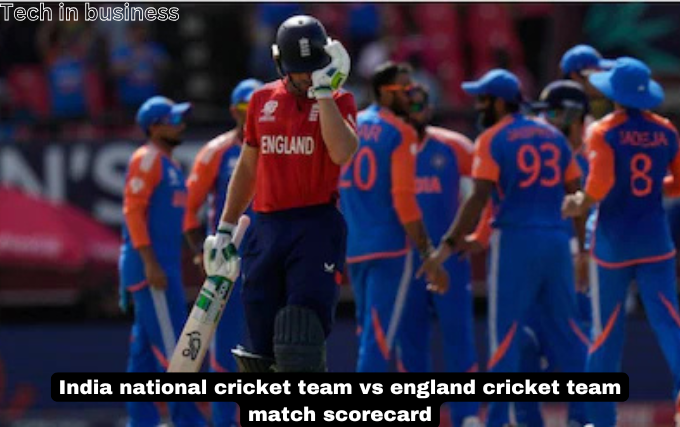The India vs England cricket rivalry has produced some of the most thrilling encounters in cricket history, and fans worldwide eagerly await every face-off between these two powerful teams. A match scorecard provides insights into the team and player performances, helping cricket enthusiasts and analysts gauge the quality and competitiveness of each match. This article explores the significance of scorecards in India vs. England games, key statistics, and what to look for when analyzing a scorecard.
What is a Cricket Scorecard?
A cricket scorecard is a detailed record of every event in a cricket match. It captures key details about batting, bowling, fielding, extras, partnerships, and much more. It is essentially the match summary that enables fans to relive or analyze the game play-by-play.
The importance of a scorecard for an India vs. England match lies in its ability to reveal the critical performances, trends, and impact of various players and strategies. For anyone wanting to understand a match’s progression or to compare two teams’ performances historically, a scorecard provides this essential breakdown.
Key Sections in a Cricket Scorecard
Each cricket scorecard follows a structured format, featuring the following main sections:
1. Batting Performance
The batting section of a scorecard details the performance of each batsman. Key metrics include:
- Runs Scored: The total runs scored by each player.
- Balls Faced: The number of balls each batsman faced.
- Boundaries: The count of fours and sixes hit by each player.
- Strike Rate: The efficiency of the batsman in scoring runs.
- Method of Dismissal: Information on how each batsman got out (e.g., bowled, caught, run out).
For example, if a player scores 80 off 55 balls, they have a high strike rate, contributing significantly to the team score.
2. Bowling Performance
The bowling analysis section gives insight into each bowler’s performance. This includes:
- Overs Bowled: The total number of overs delivered by the bowler.
- Runs Conceded: How many runs the bowler allowed.
- Wickets Taken: The number of batsmen dismissed by each bowler.
- Economy Rate: The average number of runs conceded per over.
- Best Bowling Figures: The best performance of a bowler, showing wickets taken and runs conceded in a single match.
The bowling analysis highlights bowlers’ effectiveness, crucial to restricting opponents’ runs.
3. Extras
This section records the additional runs conceded by the bowling side through:
- Byes: Runs taken when the wicketkeeper fails to collect the ball.
- Leg Byes: Runs scored off the batsman’s body without touching the bat.
- No-Balls and Wides: Runs gifted by the bowler’s errors.
Extras can significantly affect the score, particularly in high-stakes games between teams like India and England.
4. Fall of Wickets
The fall of wickets indicates how the batting lineup progressed or collapsed, showing the score at which each wicket fell. This helps gauge partnerships and pressure points during the innings.
Memorable India vs. England Encounters: A Look at Iconic Scorecards
The history of India vs. England matches boasts several iconic games, each memorable for outstanding individual performances and team efforts. Here’s a look at some of the most memorable scorecards:
1. 2011 ICC World Cup, Group Stage – Bangalore
This was one of the most memorable India vs. England encounters in recent history. The game ended in a thrilling tie, with both teams scoring 338 runs. Key highlights included:
- Sachin Tendulkar’s 120 runs: Tendulkar’s century was one of the match’s biggest highlights, propelling India to a strong score.
- Andrew Strauss’ 158 runs: Strauss’ captain’s knock matched Tendulkar’s performance, bringing England close to a win.
- Zaheer Khan’s Final Over: His tight bowling brought the game to a dramatic end.
This scorecard highlighted the strengths of both batting line-ups and underscored the pressure on bowlers in high-scoring games.
2. 2014 Test Match at Lord’s – India’s Historic Win
The Lord’s Test in 2014 saw India claiming victory at the iconic stadium after a long wait. The scorecard showcased:
- Ajinkya Rahane’s Century: Rahane scored 103 in challenging conditions.
- Ishant Sharma’s Bowling: His 7-wicket haul in England’s second innings was pivotal, with aggressive short-pitched deliveries breaking the English batting lineup.
This scorecard reflects the power of balanced performance from batsmen and bowlers.
Analyzing Recent Scorecards: What to Look For in India vs. England Games
Each India vs. England game brings a different storyline based on the pitch, team form, and individual player conditions. Here’s how to analyze recent scorecards:
1. Impact of Opening Partnerships
Opening partnerships lay the foundation for a solid innings. Strong partnerships put the batting team at an advantage, while early wickets can build pressure. A recent India vs. England scorecard that illustrates this is the 2021 Test series, where the early dismissals of openers often shifted momentum.
2. Middle Order Contributions
The middle order is crucial in stabilizing innings. Players like Virat Kohli, Joe Root, and Rohit Sharma are known to anchor and accelerate the innings in the middle overs. By analyzing the middle-order scores in recent scorecards, fans can assess the resilience of each team.
3. Bowling Strategy and Effectiveness
Indian bowlers like Jasprit Bumrah, Mohammed Shami, and Ravindra Jadeja and English bowlers like James Anderson and Stuart Broad are game-changers. The economy rate and wickets in recent scorecards show how well the bowling strategy worked, especially in high-stakes matches.
4. Fielding Impact and Extras
Extras can often determine the match result in close games. Effective fielding and disciplined bowling reduce extra runs, while poor fielding can provide the opponent with a scoring advantage.
The Future of India vs. England Matchups
The fierce India vs. England rivalry continues to grow, and future encounters will only add to the rich history between the two teams. The scorecards from these matches will record the performances of current and emerging stars, shaping cricket fans’ understanding of the game.
Predictions for Future Scorecards:
- With promising young talents like Shubman Gill and Harry Brook, future games may see higher scores and impressive partnerships.
- As England adopts a more aggressive “Bazball” approach, we may see bolder strategies, especially in Test cricket.
- In T20 and ODI formats, the rise of power hitters means fans could expect higher run rates and more thrilling finishes.
Conclusion
Cricket scorecards are more than mere records; they capture the essence of a match, documenting the highs, lows, and key moments. India vs. England encounters are iconic in international cricket, and the scorecards from these games are testaments to the skill, resilience, and competitiveness of both teams.
Whether you’re an analyst, a die-hard fan, or a casual viewer, understanding a scorecard deepens your appreciation of the game. Each scorecard tells a story—from individual heroics to collective team effort—that keeps the legacy of India vs. England matches alive for generations to come.
This guide provides insights into the components of a scorecard, historical highlights, and tips for analyzing recent games between India and England. By paying attention to scorecards, fans can better understand the dynamics of each game and the skill sets that make cricket one of the world’s most thrilling sports.


